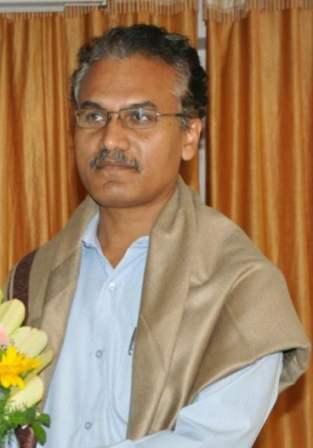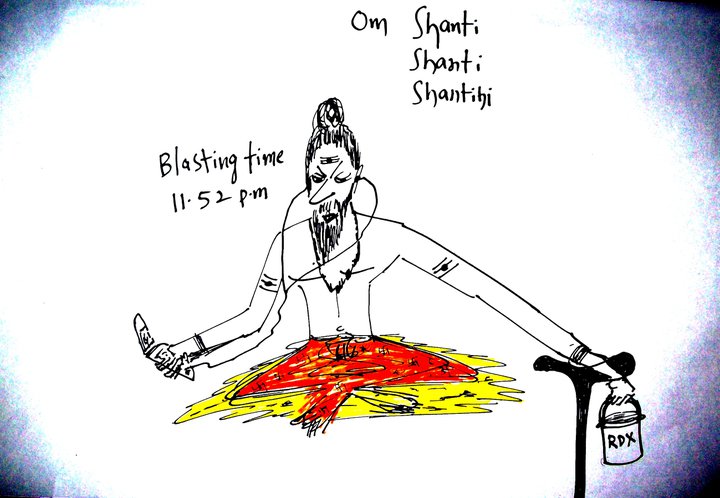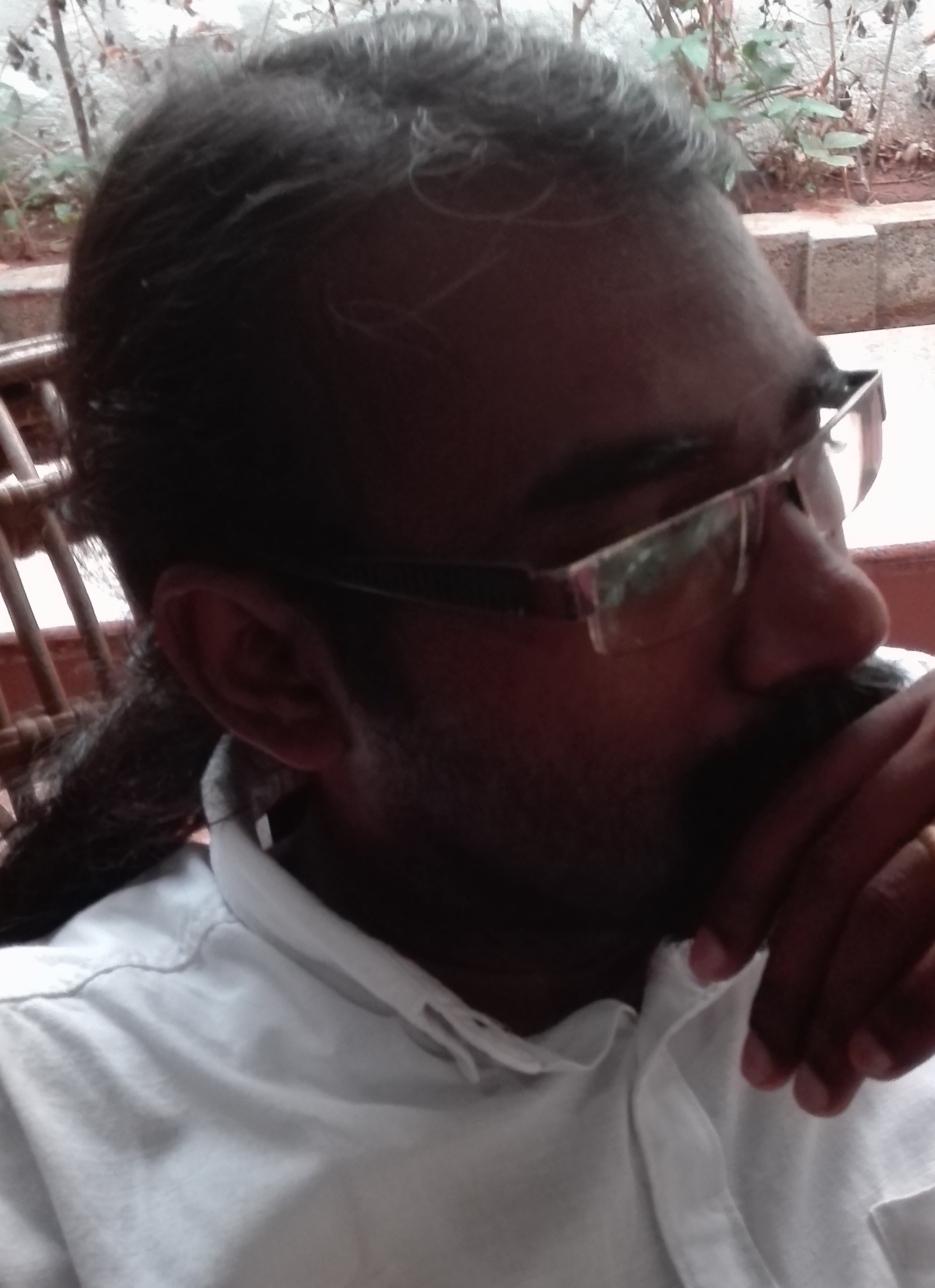Kuffir
(Text of his speech at the discussion, Debating Reservation: Rationalities and Social Justice, at the English and Foreign Languages University on 3rd September; a slightly modified talk was delivered on 4th September at the University of Hyderabad)
At UoH
Let’s consider the title of this debate: Debating Reservation: Rationalities and Social Justice. Whose perspective does it represent? What do reservations ensure? They are supposed to help the Dalitbahujans, to whatever extent possible, secure their right to education and right to livelihood. It might seem like the right to education and the right to livelihood are derived from the right to life or existence, but they are an inalienable part of it in a modern democratic society – how can you separate them? They’re part of the same primary human right, right to life or existence. Therefore, what the title suggests is: the dalit bahujan’s right to life or existence shall be discussed here.
How can you debate someone else’s right to live? Unless you’re Arnab Goswami, of course. How can you debate my right to live?
What you can perceive, implicitly, from the title of this debate is the perspective of the ruling classes. And the anxieties of the bahujan minority students who organized this event. What I see is: the university, as a state ideological apparatus, wants to discuss our right to life as policy. The ruling classes should understand: it might be policy for you, the Kautilyan state, but it is life and death politics for us.
This attitude of the ruling classes which says the Bahujan’s-right-to-life-is-a-mere-matter-of-policy, something which can be decided this way or that through negotiations, (‘maar diya jaaye ki chhod diya jaaye’) also determined this moment when this discussion is happening. The Hardik Patel moment. The Bal Thackeray cum Sardar Patel cum Hardik Patel moment.
Why is this moment causing so much excitement, across the media, academia and civil society? Why is it drawing out all kinds of anti-reservationists – from the RSS to YFE to Kejriwal kind of politicians to Jayaprakash Narayan kind of self-anointed ‘non-political’ politicians to crawl out of the woodwork to spew their usual venom on caste-based reservations and the virtues of income based ‘affirmative action’?
As I said, it would seem like everyone wants you to discuss Hardik Patel. But what they really want you to discuss is reservations, your right to life. This stands in contrast to how they treated the caste census a couple of months ago: they wanted to dismiss it, cast doubts on it, demonize it, erase it. Here, what they really wanted was that: you should not discuss your share in the country’s wealth, opportunities, power. Your stake in the Indian nation state. The former strategy is clearly a diversionary ploy, you can understand. In many ways, Hardik Patel is to the caste census, what Ram Janmabhoomi was to Mandal.
Otherwise, what’s so special about this Hardik Patel moment? The Marathas agitated earlier, and the Jats before them, and the Gujjars before them. And a couple of decades before them, the Gounders and other Vellalar jatis, and even before them the Lingayats and Vokkaligas. All as powerful, wealthy, landowning communities, on a relative scale. And all of them were sought to be included in the state backward class or central OBC lists, despite protests from various less powerful OBC groups, despite repeated rejections by various state backward class commissions and national backward class commissions, despite various high courts and supreme courts quashing the demands. And many of them succeeded in their efforts, some to a great degree, some less so.
‘Breaking up my country’
A little necessary digression: How did that happen, how did those communities succeed in getting into the reservation pool, to less or greater extent, despite the pronounced opposition of all factions of Brahmanic mainstream politics – represented by the Congress, the BJP, the CPM, the CPI, the various CPI ML groups, and the media, academia and civil society – to reservations? This opposition was so strong that Rajiv Gandhi, speaking in parliament when the Mandal Commission report was tabled, said: You’re breaking up my country –
You have taken the country to the edge of caste wars .. We have problems if caste is defined to enshrine casteism in our country. We have problems if the weakest amongst the classes are not helped and if the weakest among the minority religions are not helped. The Congress cannot stand by and watch this nation being divided for the political convenience of one individual.
Interesting, the use of the term ‘caste war’, because the RSS was to use the same term in the August 1990 issue of the Organiser, to say that the ‘one individual’ Rajiv Gandhi refers to, VP Singh, was promoting ‘caste war’. Such total agreement among so-called die-hard opponents!
Rajiv Gandhi also went on to say, about the list of castes:
Many castes that are listed in (this) list are forward castes and are scheduled castes … I know for a fact that Brahmins are included, Reddys are included, Vokkaligas are included, Kammas are included, Lingayats are included, Gounders are included, Chettiyars are included. Are these backward castes? Do they need the help? This is how 52 per cent has been derived.
We know for a fact now that the Brahmins are not included, the Reddys are not included, the Kammas are not included, not all the Lingayats are included, not all the Chettiyars are included..but the Gounders are included, and their inclusion required Rajiv Gandhi’s own party amending Schedule 9 of the constitution in 1994, only a couple of years after he had opposed Mandal in parliament.
I ask again: how did some of these powerful communities – like the Lingayats, Vokkaligas, Chettiyars and Gounders etc., and later Jats in Western UP and Rajasthan, and all of Marathas in Maharashtra almost – find their way partly or wholly into the state and central backward classes lists?
Because there was unwritten political consensus among all factions of Brahmanic mainstream politics – represented by the Congress, the BJP, the CPM, the CPI, the various CPI ML groups, and the media, academia and civil society. In recent times, the BJP raised the issue of reservation for Jats in Rajasthan and Congress followed it up. The Congress pushed the agenda for including Jats in 9 states in the OBC list, dismissing all backward classes commissions’ opposition to the move. The move was scuttled by the courts, but the BJP is now following it up. Same is the case with the Maratha quota.
The Congress proposes, while the BJP reinforces. Or vice versa. What is left or right or centre in India?
Reservations for the powerful vs reservations for the weak
So that’s the answer to the question: how did these powerful communities succeed in getting into the reservation pool, to less or greater extent, despite the pronounced opposition of all factions of Brahmanic mainstream politics – represented by the Congress, the BJP, the CPM, the CPI, the various CPI ML groups, and the media, academia and civil society – to reservations, in principle? The answer is that all those political actors like the powerful.
Are they really opposed to, or in favour of reservations? They’re opposed to reservations, unitedly, as long as they are meant for the politically weak, deprived, socially excluded communities. When it comes to reservations for the political powerful, wealthy, socially privileged communities they bend over backwards to break laws, norms and judicial orders to accommodate them.
There are too many examples to illustrate this: too many muslim communities are still not recognized as OBCs, it takes decades and decades for the state to even ‘discover’ the most vulnerable and the weak. In the past one decade, among the communities recognized as backward in the state of Andhra Pradesh are: the Siddula, a community which has a population of only 5,000; their traditional occupation is selling of kumkum, gulal, combs and manual labour; only 10% are literate. It was never referred to earlier in any ethnographic records, it has no presence in government even at grade 4 level or in any professions. The Arava community is only 3,300 strong; 93% of its members are engaged in manual labour, only 1 member is employed in government. Their per capita incomes are around 1/8th state’s average. Kurakula – their traditional occupation was to sell vegetables but 97% of them are now engaged in manual labour, earning around 1/10th the state’s average income. The Samanthula are another such community which was recorded as the poorest community in the state in the Andhra Pradesh Multi-purpose Household Survey held in the year 2000.
It took the Indian state 60 years to ‘discover’ these jatis. Now the ruling classes are proposing that the Patels are as wretched as these lost communities.
And now, going back to the earlier, original question: what’s so special about this Hardik Patel moment? The Hardik Patel moment is special because it signifies the culmination of all those earlier projects to make powerful communities ‘backward’, to de-caste reservations. To normalize the discourse of their righteous demand for state support through reservations on the grounds that some of them are very ‘poor’ and are suffering despite their ‘merit’.
Now they’re all geared up: to harvest the accumulated capital of so many anti-reservations movements and discourses. That’s the significance of the Hardik Patel moment.
Where’s rationality? Can the Brahmin-Savarnas think clearly on reservations?

The peculiar selective vision that the ruling classes employ to measure ‘backwardness’ or ‘poverty’: one poor Brahmin among ten prosperous Brahmins proves that all Brahmins are poor. Whereas one prosperous Dalit or Adivasi or OBC among ten poor Dalits or Adivasis or OBCs proves that all of them are prosperous.
How can you deal with such ‘rationality’?
The Brahmins dominate state machinery, over 40% of all top central government jobs are occupied by them. They dominate media, judiciary, they dominate organized industry – both public and private sector – they occupy 44% of positions in corporate boards. They dominate the judiciary and academia much more.
All this means they’re the most secure social class in modern India, across regions and languages. You could say the majority of Brahmin households are direct or slightly indirect wards of the Indian state, its first citizens or perhaps its only citizens, its nation.
Where’s the rationality in Brahmins objecting to reservations?
The Jats of Punjab and Haryana are special sons-in-law of the Indian state. Nearly half of all procurement of cereals, wheat and rice, undertaken by the Indian government is from Jat farmers. They own over 70% of the land in those two states and probably half of legislative positions and two-thirds of chief ministerial positions until now.
Where’s the rationality in the Jats demanding reservations?
The Marathas own nearly 85% of land in Maharashtra, run most of its sugar and other agro-processing mills, occupy 40-55% of elected legislative positions, majority of chief ministerial positions.
Where’s the rationality in the Marathas demanding reservations? Or in the Lingayats being given reservations or the Gounders being given reservations?
Among the ruling classes, there has generally been talk over the last decade or so of introducing a 10% quota for the ‘poor’ among the upper castes, especially Brahmins. A 10% quota for the poor among a section of population that must be around 15% (of total Indian population)?
Are two thirds of the upper castes poor? This quota is so irrational that it leaves you stupefied. A quota several times the share of the upper caste poor. Think of what the SC/STs and OBCs get.
If you piece together all these facts, you get a picture of total irrationality:
~ The Brahminized classes oppose reservations for most marginalized groups among all categories, but unitedly support reservations for powerful communities.
~ They oppose caste based quotas but will support the caste based claims of Marathas, Jats, Patels, Lingayats, Gounders, Khandayats, Kapus, Nairs and Reddies and Velamas.
~ They talk about ‘creamy layers’ among the SC/STs and OBCs, and the need to skim them but will never look at the original creamy layer, the Brahmins and upper castes themselves.
~ They focus on the poor Brahmin who’s an exception among the Brahmins at large as a more significant victim, but will not consider the poor among the SC/ST/OBCs, who form the majority among them, as significant victims.
Where’s rationality in the ruling classes’ thinking?
In a note circulated yesterday, VT Rajshekar of Dalit Voice, says – and this is the best, crispest description of Brahmanic rationality:
We want to warn SC/ST/OBC’s & minorities accused of meritlessness & inefficiency that the upper caste merit mongers are not going to be convinced by learned arguments & scientific reasons.
They have their own logic which says that what they say is right & what others say is wrong. Even the most educated pundit speaks this way. The upper caste hindus believe what they want to believe.
Their Policies vs Our Politics
We’re caught in the Hardik Patel moment, we’ve led ourselves into a battleground where both the agenda for discussion and the rules of engagement have been laid down by the ruling classes, or the ‘governing classes’ as Babasaheb called them.
Let’s look at the title of this debate once again: ‘Debating Reservation: Rationalities and Social Justice’.
We’ve been trapped into discussing ‘reservations’, into debating whether we should have the right to live as pointed out earlier. We’ve been trapped into thinking we face a ‘rational’ adversary. We’ve been trapped into aiming for social justice, and not getting even social recognition.
If large sections of people, the majority, remain unrepresented or under-represented in all state institutions, in political society and in civil society: should even the debates on this absence of representation and under-representation be dominated by those who are excessively over-represented in all spheres?
Manyawar Kanshi Ram Saheb advocated social transformation, not mere social justice. He said:
To my mind, all parties represent the forces of status quo. For us, politics is the politics of transformation. The existing parties are the reason for the status quo. That is why there has been no upward mobility for the backward communities. The communist parties have become the biggest stumbling block in this regard. They keep talking about change, but work for status quo. The BJP is better, they never talk about change. So people never feel duped. Parties like the Congress and communists talk about abolishing poverty, but work towards keeping people poor. If the poor are not kept poor, these people cannot remain in their seats.
So how can we debate with the forces of the status quo and believe this will ensure social justice, forgetting our goal of social transformation?
Reservations are not what we need to discuss, we’ve to debate caste, its cause.
Hardik Patel is not what we need to discuss, it’s the caste census that we needed to discuss, two months ago, almost exactly twenty five years after Rajiv Gandhi ridiculed the Mandal Commission, demanding where’s the data? If two months ago, the universities had started talking about the caste census, Hardik Patel wouldn’t even have happened.
It’s not their policies that we’ve to debate, it’s our politics that we’ve to discuss.
We need to discuss, who stole our lands?
The caste census says, in brahmin india – from east to west, north to south- there are nearly 6.86 crore landless households. of these, nearly 1.81 crore are SC households, and nearly 70 lakh are ST households. Who are the other 4.34 crore landless households? They’re definitely not brahmin-savarna. What the Hardik Patel tamasha seeks to drown out is the fact that the great majority of those landless ‘others’ are OBC.
They may try to hide it, bury it, burn it – but the larger truth is out.
We need to discuss, who appropriated our labour?
Over 13 crore rural households earn less than 5, 000 per month. 2.7 crores of them are SC households (83% of all rural SC households), 1.7 crore of them are ST households (86%) and other households are 8.9 crore (the great majority of them would be OBC households).
We need to discuss, who stole our jobs?
If over 75-80% of all organized sector jobs are owned by a 15% minority, shouldn’t we be discussing that?
We’re the ‘servile class’, as Dr Ambedkar said, in the eyes of the ‘governing class’. We’re to be subjected to policy, to schemes, subsidies, sops.
We need to discuss how to change that. Dr Ambedkar, laying down some ground rules for the ideal Indian constitution (‘A Plea to the Foreigner’), says:
The principal aim of such a constitution must be to dislodge the governing class from its position and to prevent it from remaining as a governing class. [italics mine]
Shouldn’t that be our aim? The principal aim of our politics must now be to dislodge the governing class from its position and to prevent it from remaining as a governing class.
All we need to discuss now is: how do we go about doing that, how to restrict and reduce the domination of the ‘general category’ (or ‘governing class’) everywhere – in land, jobs, power.
We don’t need to fall into their trap and discuss ‘reservations’.
You’ll see it is a trap, when you observe what they’re talking about now: why don’t they insist on scrapping reservations altogether, why do they talk only of ending caste based reservations? Because reservations save the ruling classes from definite violent resistance, while offering minor relief to the dalitbahujans.. I repeat, reservations save the brahmin-savarnas, not the dalitbahujans.
Let’s not be anxious about reservations, our politics should aim to cleanse the general category of caste, because it is the general category which harbours caste, not the reserved category.
~~~
Cartoon by Unnamati Syama Sundar.









